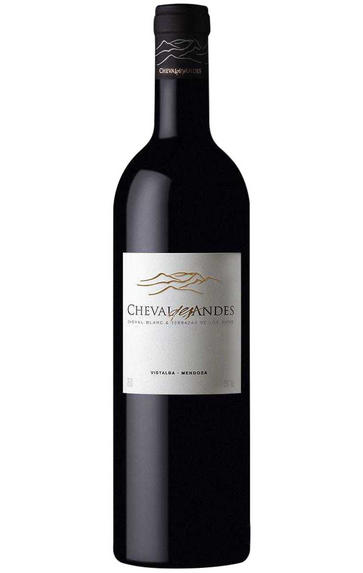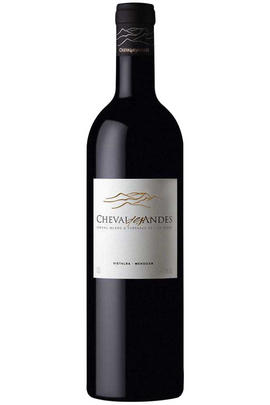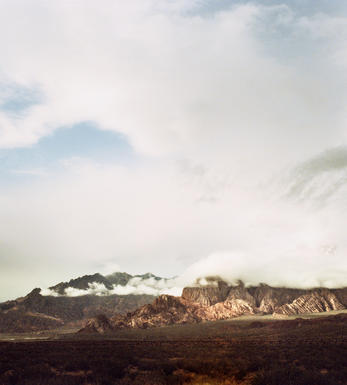
2015 Cheval des Andes, Mendoza, Argentina

Critics reviews
500l oak casks for ageing for the first time, with the percentage of new oak brought down to 50%. 90% of their own plots were by this point going into the wine, with just 10% from Terrazas de los Andes.
Love the smoky edge to this wine with its clear graphite, liquorice and spice notes, and its fragrant violet aromatics. There is a feeling of density to the entire thing, with the tannins doing their job of cradling and guiding the blueberry and raspberry fruit. An excellent, sure-footed wine, with no Petit Verdot for the first time and yet still delivering plenty of pep, and overall the balance is striking.
Drink 2021 - 2040
Jane Anson, Inside Bordeaux (October 2021)
About this WINE

Cheval des Andes
Cheval des Andes is a wine estate in Mendoza, Argentina. It is a collaboration between Château Cheval Blanc of Bordeaux and Terrazas de los Andes of Mendoza.
The idea for the project came from Pierre Lurton, then the president of Cheval Blanc, and winemaker Roberto de la Mota. Their goal was to produce a “Grand Cru” equivalent wine in Las Compuertas, a sub-region of Luján de Cujo in Mendoza. The first vintage of Cheval des Andes was 1999.
The vineyard sits at up to 1,070 metres elevation, creating a cool microclimate for the grapes to ripen slowly. Malbec is the dominant variety here. The vineyard boasts old, ungrafted vines of Malbec that were planted in 1929.
There is also a healthy proportion of Cabernet Sauvignon, along with a small amount of Petit Verdot. Pierre Lurton was particularly interested in Malbec, given its historical significance in St-Emilion – and its huge popularity in Argentina.
Since 2019, Cheval des Andes has been distributed through La Place de Bordeaux. The first vintage released this way was the 2016.

Mendoza
With its western borderline dominated by the Andes and its 146,000 hectares of vineyards representing 70% of the country’s wine production, Mendoza is Argentina’s biggest and most important wine-growing province.
Mendoza’s vineyards are a haven to Old World varieties including Cabernet Sauvignon, Merlot, Syrah, Tempranillo, Bonarda, Sangiovese, Barbera, Chardonnay, Sauvignon Blanc and Chenin Blanc. The province’s signature grape is Malbec.
Mendoza still produces large amounts of inexpensive wine for domestic consumption, as well as grape concentrate, but the sub-region of Luján de Cuyo stands out with some lovely velvety Malbecs, while the cool, gravelly Maipú is best for Cabernet Sauvignon.
The most exciting area in Mendoza for fine whites, however, is the Uco Valley, that has the highest vineyards, up to 1,200 metres above sea level. Chardonnay, Sauvignon, Chenin, Pinot Grigio and Torrontés fare particularly well in its cool climate. Its sub-region of Tupungato produces Argentina’s best Chardonnay.

Cabernet Sauvignon Blend
Cabernet Sauvignon lends itself particularly well in blends with Merlot. This is actually the archetypal Bordeaux blend, though in different proportions in the sub-regions and sometimes topped up with Cabernet Franc, Malbec, and Petit Verdot.
In the Médoc and Graves the percentage of Cabernet Sauvignon in the blend can range from 95% (Mouton-Rothschild) to as low as 40%. It is particularly suited to the dry, warm, free- draining, gravel-rich soils and is responsible for the redolent cassis characteristics as well as the depth of colour, tannic structure and pronounced acidity of Médoc wines. However 100% Cabernet Sauvignon wines can be slightly hollow-tasting in the middle palate and Merlot with its generous, fleshy fruit flavours acts as a perfect foil by filling in this cavity.
In St-Emilion and Pomerol, the blends are Merlot dominated as Cabernet Sauvignon can struggle to ripen there - when it is included, it adds structure and body to the wine. Sassicaia is the most famous Bordeaux blend in Italy and has spawned many imitations, whereby the blend is now firmly established in the New World and particularly in California and Australia.


Buying options
Add to wishlist
Description
500l oak casks for ageing for the first time, with the percentage of new oak brought down to 50%. 90% of their own plots were by this point going into the wine, with just 10% from Terrazas de los Andes.
Love the smoky edge to this wine with its clear graphite, liquorice and spice notes, and its fragrant violet aromatics. There is a feeling of density to the entire thing, with the tannins doing their job of cradling and guiding the blueberry and raspberry fruit. An excellent, sure-footed wine, with no Petit Verdot for the first time and yet still delivering plenty of pep, and overall the balance is striking.
Drink 2021 - 2040
Jane Anson, Inside Bordeaux (October 2021)
wine at a glance
Delivery and quality guarantee